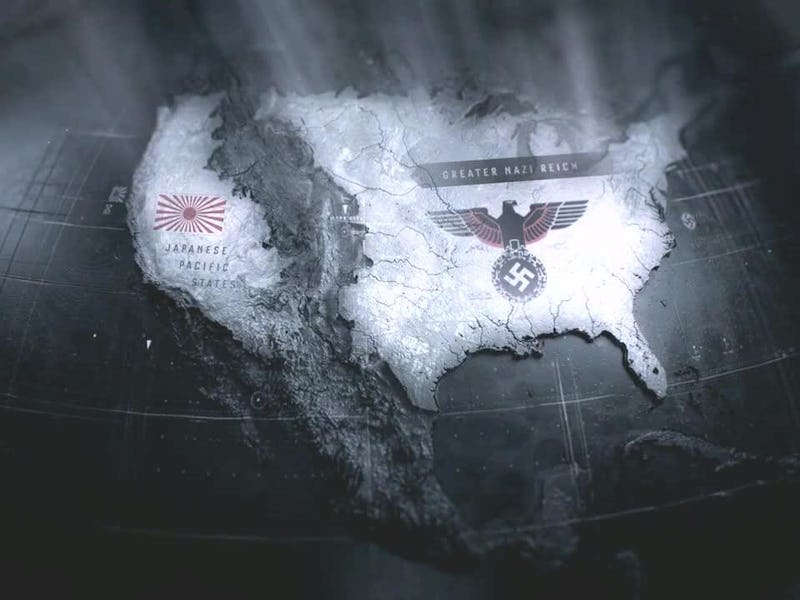Amazon’s First Original Sci-Fi Series Remains One Of Its Best
Fascism in America? Could you imagine?

As Amazon dumps cement mixers full of money into Rings of Power, Wheel of Time, Fallout, and The Boys-verse, it’s easy to forget that the idea of the company that overnights paper towels and golf balls to your home making its own television programs was once considered risky and a bit absurd. But while it was Netflix that opened up a new front in the streaming wars by releasing House of Cards and Orange is the New Black to significant acclaim, Amazon soon joined the rush to reframe such services as not just digital warehouses for old shows, but pop culture destinations in their own right.
Most of its early efforts were failures. Good Girls Revolt, essentially “Mad Men for Women,” was ignored. Vox’s Emily St. James called Hand of God, a vigilante cult thriller, “excruciatingly terrible.” Z: The Beginning of Everything, a forgotten drama about the life of Zelda Fitzgerald, summed up the fact that Amazon had no apparent idea who its users were or what they wanted. But the streamer has since found tremendous success with genre television, a transformation that began when The Man in the High Castle debuted 10 years ago today.
Based on Phillip K. Dick’s dreamy alt-history novel, the series is set in 1962, after most of the world has been divvied up between a victorious German Reich and Japanese Empire that now find themselves on the brink of a new conflict. The United States has been sundered, with Japan colonizing the west coast, Germany claiming the east and Midwest, and Denver serving as the capital of a narrow neutral zone.
The logistics and geopolitics are a bit fantastical, but the show’s sheer sweep is captivating. Plots set in San Francisco, New York City, and the neutral zone show us what life is like for the intermingling occupied, occupiers, and homegrown collaborators. Meanwhile, the mysterious title character provides the American Resistance with film clips seemingly taken from realities where the Allies emerged triumphant. With an aging Hitler facing his final days, his bloodthirsty underlings jockey for power while a rogue German officer and Japanese minister conspire to keep the peace.
While the debut episode isn’t immune to some clunky exposition, it also highlights the series’ intelligence. Joe Blake (Luke Kleintank), a young man driving a truck from New York City to the neutral zone on behalf of the Resistance, has to shoot his way out of trouble in the opening minutes, and when he blows a tire and encounters a nosy cop in the middle of nowhere, you’d assume a similar solution is on the horizon.
Young men like Joe have known nothing but seemingly-normal fascism.
Instead, the cheery officer is nothing but helpful, changing Joe’s tire for him and even offering him lunch. The cop, an American veteran who sees World War II as a hazy memory not worth fussing over, then casually explains that the ash falling around them is from the local hospital’s routine incineration of undesirables. It’s easy — and lazy — for dystopian stories to make every authority figure a cold monster, but The Man in the High Castle is a story about a country affably occupying itself.
No one embodies this better than Rufus Sewell, whose Obergruppenführer John Smith, another veteran turned authoritarian cog, is a brilliant and ruthless SS officer who took to American fascism like a fish to water. The underrated Sewell brings an icy magnetism to the character and his ruthless defense of the Reich, and Smith still serves as a timely reminder that yesterday’s patriot is often all too happy to become tomorrow’s jackboot.
The Man in the High Castle would add dashes of sci-fi as the series marched on, and while a weak second season blunted much of its momentum, it ultimately remained a compelling thriller throughout its four-year run. Most importantly, the show gave Amazon a critical and commercial success: it was the most watched of Prime’s early originals, making it clear the streamer’s future lay in genre television, not, with respect to her fans, Zelda Fitzgerald dramas.
Sewell’s Smith provides an uncomfortable reminder that our beliefs are more malleable than we think.
In retrospect, some of the feedback it received is now delightfully quaint. Critics wondered if $179 million was a reasonable bill for two seasons of a steaming series, especially since there was a whole — brace yourself — 13 months between them. For modern context, the first season alone of Rings of Power cost $462 million, and it took two years to get Season 2 out the door.
But despite the Tolkien prequel facing a decidedly mixed reception, there are rarely questions, as there were during High Castle’s day, of whether the show (and its platform) is good enough to stick around. St. James called the second season of High Castle a poor effort that mistook expense for quality, and questioned whether Prime Video had the industry expertise to ever be anything more than an also-ran. But for better or worse, streamers throwing absurd amounts of time and money at genre projects has become the norm, and the success of shows like Fallout reveals that Amazon learned the painful lessons of High Castle’s sophomore stumbles.
The Man in the High Castle has largely been overshadowed by its bigger and younger siblings, but, appropriately for its alt-history setting, it’s easy to imagine the streaming landscape looking quite different had it failed. Instead, its success signaled that finding high-quality genre TV outside of your cable package would become routine. The world it built is here to stay, and it remains well worth watching in its own right.